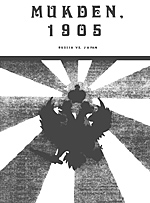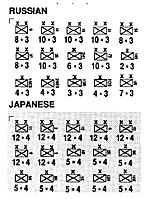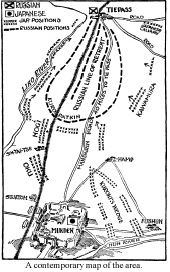
Mukden, 1905
Designer: Richard Spence
Developer: James Gabel
Publisher: Spence & Gabel, 1976
Players 2
Playing time not indicated
Scale Strategic
Units Division and Brigade
Map 3 miles per hex
Time 1 day/turn, 18 turns/game
Components
1 17"x22" unmounted 2-color map
1 8-page rules booklet
80 2-color uncut single-sided counters
1 ziploc bag
 Counter Manifest
Counter Manifest
Russian (black on white)
- 9 10-3 Infantry Divisions
3 9-3 Infantry Divisions
5 8-3 Infantry Divisions
5 7-3 Infantry Divisions
1 6-3 Infantry Brigade
1 4-3 Infantry Division
3 4-3 Infantry Brigades
3 3-3 Infantry Brigades
2 2-3 Infantry Regiments
1 3-6 Cavalry Division
1 2-6 Cavalry Division
1 1-6 Cavalry Division
1 1-6 Cavalry Brigade
4 Army HQ
Japanese (black on pink)
- 1 13-4 Infantry Division
12 12-4 Infantry Divisions
14 5-4 Infantry Brigades
1 3-6 Cavalry Brigade
1 1-6 Cavalry Brigade
1 6-3 Artillery Brigade
1 6-2 Artillery Brigade
2 5-4 Artillery Brigades
2 2-4 Artillery Regiments
5 blanks
What the Designer says:
“Mukden, 1905 is a division-brigade level simulation of the climactic battle of the Russo-Japanese War.
What the Reviewers say:
Mukden, 1905 is a fairly simple game. It is not, however, simplistic. The Russian Command Control rule adds an unpredictable element which is unlikely to make any two games the same. Some will complain that this rule is too restrictive. It does make a Russian offensive a risky business but in doing so it aptly portrays the almost incredibly inept command structure which plagued the Russians throughout the war. To leave that out would have ignored one of the most critical elements of the battle.”
“Richard Spence and James Gabel are a pair of game designers publishing their own series of games. This one is their oldest. ... It is a nice, uncomplicated, but not simplistic, easy-to-learn game. The components and graphics are as good or better than most independent-designer or small company games.” --Don Lowry in Campaign 80.
“Mukden, 1905 is really Napoleon at Waterloo visiting Manchuria in his off season. With a few changes that remind one of SPI’s Lee vs Hooker or the new Napoleon’s Last Battles Quad; plus a few changes to reflect the campaign around Mukden -- one has the rules for Mukden, 1905. This makes for few rules hassles, and results in a short and interesting game. But it is sad to think that a slightly different or unique approach could not have been made...” Jack Greene in F&M 6 “Moderately simple, average length.” S&T 60
Player’s Value
 A contemporary map of the area.
A contemporary map of the area.
The Russo-Japanese War is not well known amongst gamers, nor is it particularly popular. This is not surprising as the war was remote, a bit mysterious, and quickly overshadowed by World Wars I and II. This is also unfortunate, as the war marked several important turning points.
[Warning! The following two paragraphs contain historical content which may not be suitable for all ages. Reader discretion is advised. -ed]
Around the turn of the century, Russia was the largest, strongest and most powerful country in the world, and was treated with appropriate deference by the other nations of Europe. Russia’s interests lay in the east, and she badly wanted a year-round ice-free port for her Pacific fleet at Port Arthur, as well as an unbroken land link connecting the east and west coasts. Russia’s interests in Manchuria and Korea conflicted with the Japanese sphere of influence, but Russia underestimated Japan’s determination and failed to follow through on its promise to withdraw from Manchuria.
Japan went to war. The Japanese siege of Port Arthur eventually succeeded, with enormous losses on both sides. The subsequent Japanese attacks on the withdrawing Russians, which culminated at Mukden, had the same results ... success but at a high cost for both sides. The Russians made one last effort to recapture Port Arthur by sending its Baltic Fleet halfway around the world, but it was annihilated by the Japanese fleet at the Battle of Tsushima. Japan had achieved her limited aims, and internal discontent in Russia put paid to any further efforts.
This short war was the bloodiest to date, surpassing even the American Civil War in casualties. Japan proved that she was a world power, on land as well as at sea. The European powers were demonstrably no longer invincible. And it was the first and last great fleet action of the ironclad predreadnought era. David had well and truly defeated Goliath.
Mukden, 1905 places command control restrictions on the Russians that simulate their atrocious leadership and effectively neutralize the valor and morale of their troops. However, the victory conditions work against the Japanese to such an extent that if the actual war had been decided by these Victory Points, the Japanese would have lost.
Collector’s Value Spence & Gabel collaborated on and produced a total of four games in 1977. The production run is unknown, but is likely not over 2,000 copies per title. The production quality is generally quite good, and certainly consistent with other games of the period. One anomaly I must comment on is the fact that although reviewers indicate that the game came with mounted diecut counters, the copy I have contains uncut and unmounted counters printed on plain cardstock. Boone lists low, high and average prices of 5/23/11.22 at auction and 9/45/21.75 for sale.
Other Games by these Designers
Kaiserschlacht 1918 (S&G, 1977)
Koniggratz (S&G, 1977)
Tannenburg (S&G, 1977)
Gallipoli (Paper Wars, 1979)
Bitter End (Quarterdeck, 1983)
Kaiserschlacht 1918 (Excalibre, 1992)
Henderson Field (Quarterdeck, not published)
Other Games of this Type and/or Era
Russo-Japanese War (Bandai);
Tsushima (International Wargamer, 1972);
the Siege of Port Arthur (Strife, 1975);
Port Arthur (GDW, 1976);
Tsushima (GDW, 1976);
the Russo-Japanese War (GDW, 1976) [Port Arthur plus Tsushima];
the Battle of Tsushima (3W, 1989);
Port Arthur (XTR, 1992);
Mukden (XTR, 1996);
the Russo-Japanese War (Avalanche Press, 1999).
Back to Simulacrum Vol. 3 No. 3 Table of Contents
Back to Simulacrum List of Issues
Back to MagWeb Master Magazine List
© Copyright 2001 by Steambubble Graphics
This article appears in MagWeb (Magazine Web) on the Internet World Wide Web. Other military history articles and gaming articles are available at http://www.magweb.com